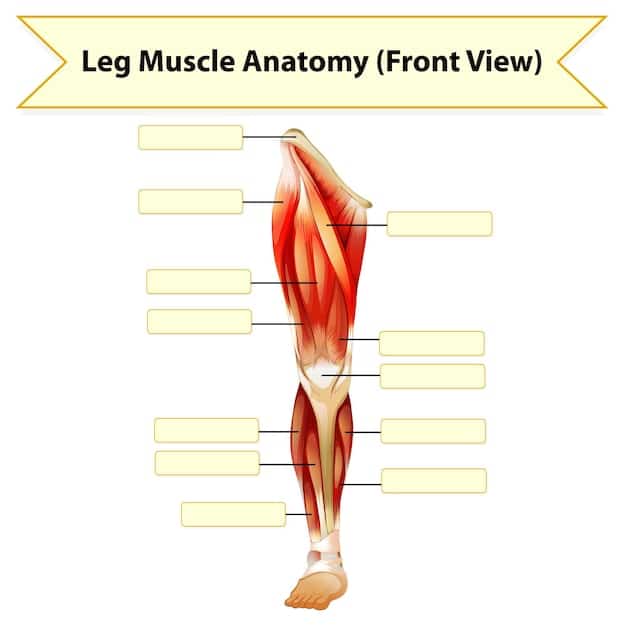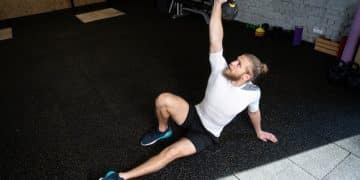Isometrics for Strength: Boost Your Deadlift in 7 Days

Isometric training offers a potent, low-impact method to significantly enhance deadlift performance by strengthening specific joint angles and improving neural drive, making it an essential component for lifters aiming for new personal bests.
Are you looking to shatter your deadlift plateaus and unlock new levels of strength? The journey to a stronger deadlift often involves more than just lifting heavy; it requires strategic, targeted training. This is where Isometrics for Strength: A 7-Day Plan to Boost Your Deadlift comes into play, offering a unique and exceptionally effective approach to building raw power precisely where you need it most.
understanding isometrics: the science of static strength
Isometric contractions involve engaging a muscle without changing its length, meaning no joint movement occurs. Think of pushing against an immovable object or holding a heavy weight at a fixed point; these are classic examples of isometric exercises. Unlike dynamic movements (concentric, where muscles shorten, and eccentric, where they lengthen), isometrics focus on maximum tension production at specific joint angles.
The beauty of isometric training lies in its ability to generate incredible amounts of force without the associated wear and tear on joints that often comes with heavy dynamic lifting. This makes it an invaluable tool for both strength development and injury rehabilitation, offering a powerful yet low-impact way to build serious muscle. Moreover, isometrics can drastically improve your body’s ability to recruit more muscle fibers, enhancing neural drive and teaching your nervous system to fire muscles more efficiently.
The “sticking point” advantage
Every lifter knows the dreaded “sticking point” – that specific range of motion where a lift feels heaviest and often fails. For the deadlift, this could be off the floor, just above the knees, or during the lockout. Traditional training often struggles to effectively address these weak links because dynamic movements quickly pass through them. Isometrics, however, allow you to hold maximum tension precisely at these critical points.
By engaging in isometric holds at your personal sticking points, you force your muscles to generate peak force in that compromised position. This targeted approach trains the specific muscle groups and joint angles that are weakest, effectively turning a vulnerability into a strength. The result is a more resilient and powerful deadlift, capable of pushing through those previously insurmountable barriers.
enhancing neural drive and motor unit recruitment
One of the less obvious, but profoundly impactful, benefits of isometric training is its effect on the nervous system. When you perform an isometric hold with maximal intent, your brain and spinal cord learn to activate a higher percentage of your motor units – the nerve cells that control muscle fibers. In essence, you teach your body to become more efficient at switching on and utilizing its full muscular potential.
This improved neural drive translates directly to dynamic lifts like the deadlift. When your nervous system is better at recruiting muscle fibers, you can generate more power and brute strength from the very beginning of the lift, making the entire movement feel lighter and more controlled. This is not just about muscle size; it’s about making the muscles you have work harder and smarter.
- Increased Force Production: Isometrics can generate 10-15% more force than dynamic contractions.
- Joint Angle Specificity: Strengthens muscles precisely where they are weakest in a lift.
- Low Joint Strain: Minimal joint movement reduces stress and risk of injury.
- Enhanced Neural Adaptation: Improves the brain’s ability to recruit motor units.
Ultimately, understanding the science behind isometric contractions is the first step toward appreciating their profound impact on overall strength, particularly for compound movements like the deadlift. It’s about optimizing your body’s internal machinery to produce more power efficiently and safely.
deadlift mechanics: identifying your weak links
Before diving into a 7-day isometric plan, it’s crucial to understand the biomechanics of the deadlift and identify where your personal weaknesses lie. The deadlift is a full-body exercise, engaging the glutes, hamstrings, lower back, lats, traps, and forearms. A breakdown in any of these areas can compromise the entire lift.
Start by analyzing your current deadlift form. Record yourself from the side and front. Pay attention to how the bar breaks from the floor, how it moves past your knees, and your lockout. Do your hips shoot up prematurely? Does the bar slow down significantly at a certain point? Does your back round? Pinpointing these issues is the foundation of a targeted isometric plan.
common deadlift sticking points and their isometric solutions
Different lifters have different weaknesses, but some sticking points are more common than others. Understanding these can help you select the most effective isometric exercises.
- Off the Floor (Initial Pull): If the bar struggles to break from the ground, your weakness might be in initial leg drive, hip strength, or lats not creating enough tension to pull the slack out of the bar. Isometric solutions include rack deadlift holds from the floor or just an inch above, focusing on maximal tension against an immovable bar.
- Mid-Shin to Above the Knee: This is a common sticking point where the angle changes significantly. Weakness here often points to glutes and hamstrings not being strong enough through this range, or insufficient upper back tension to keep the bar close. Isometric exercises like mid-thigh rack deadlift pulls or standing overhead holds (simulating the final upright posture) can be highly effective.
- Lockout: If you struggle to stand tall at the end of the lift, your glutes, hamstrings, and lower back might be weak in their fully extended position. Isometric rack pulls from just below the lockout point, or even simply holding a heavy weight in a fully locked-out position, provide targeted strength gains.
the role of the core and grip in the deadlift
While not primary movers, a strong core and an iron grip are foundational to a successful deadlift. A weak core allows spinal flexion, increasing injury risk and reducing power transfer. A weak grip is often the first thing to fail, even if your legs and back are strong enough.
For the core, isometric holds like planks, side planks, and hollow body holds, performed with maximal abdominal bracing, will significantly enhance stability. For grip, simply holding a heavy barbell or dumbbells for extended periods (farmer’s walks or static holds) is incredibly effective. Incorporating these general isometric principles will provide a strong base for your specific deadlift work.
By conducting a thorough self-assessment and understanding the specific demands of each phase of the deadlift, you can tailor your isometric regimen to address your unique needs, moving from generic strength building to highly personalized and effective support for your lifting goals.

the 7-day isometric deadlift plan: structure and execution
This 7-day plan is designed to integrate isometric training into your existing routine, rather than replace it. It focuses on strategic implementation, allowing your body to adapt without excessive fatigue. Remember, the goal is to enhance your deadlift, not overtrain.
The plan assumes you will dedicate 10-15 minutes to isometric work each day, potentially before or after your main workout, or even on rest days if your main lifts aren’t too taxing. Consistency is key, and the short duration makes daily adherence manageable.
day-by-day breakdown: focused isometric holds
Each day targets a specific aspect of the deadlift or a complementary muscle group. The key is to perform these holds with maximal concentric effort, as if you are trying to move an immovable object.
- Day 1: Initial Pull Strength (Off the Floor)
- Exercise: Rack Deadlift Hold (Bar just off the floor, or 1-2 inches above)
- Sets/Reps: 3-4 sets of 5-8 second holds at maximum effort.
- Focus: Explosive leg drive, maintaining a tight back, tension in lats to pull slack.
- Day 2: Mid-Range Power (Above the Knees)
- Exercise: Mid-Thigh Rack Pull Hold (Bar positioned 1-2 inches above the knee)
- Sets/Reps: 3-4 sets of 5-8 second holds at maximum effort.
- Focus: Glute and hamstring engagement, pushing hips forward, maintaining upper back rigidity.
- Day 3: Lockout Stability and Strength
- Exercise: Upper Thigh/Lockout Rack Pull Hold (Bar just below hip level, simulating lockout)
- Sets/Reps: 3-4 sets of 5-8 second holds at maximum effort.
- Focus: Full hip extension, glute squeeze, standing tall without hyperextension.
- Day 4: Core and Back Resilience
- Exercise: Heavy Barbell Static Hold (Standing tall, holding a heavy barbell)
- Sets/Reps: 3-4 sets of 10-15 second holds.
- Focus: Bracing the core, maintaining a neutral spine, resisting forward lean.
- Day 5: Grip and Forearm Domination
- Exercise: Farmer’s Walk Static Holds (Holding heavy dumbbells or kettlebells)
- Sets/Reps: 3-4 sets of 15-20 second holds.
- Focus: Squeezing with maximum grip strength, resisting drop.
- Day 6: Recovery and Active Tension
- Exercise: Light Band Pull-Aparts / Light Dumbbell Rows (Focus on muscle activation, not heavy lifting)
- Sets/Reps: 2-3 sets of 15-20 reps, focusing on slow, controlled tension.
- Focus: Blood flow, muscle activation in a non-fatiguing manner.
- Day 7: Full Range Isometric Pull / Rest
- Option 1 (Advanced): Isometric Full Deadlift Pull (Push against a safety pin system from various points on the lift path if possible)
- Option 2 (General): Complete Rest. Allow the body to recover fully before resuming dynamic training.
implementation notes and safety
Always warm up adequately before performing isometric holds. A few minutes of light cardio and dynamic stretches are essential. When performing the holds, truly strive for maximal effort. Imagine you are trying to lift hundreds, even thousands, of pounds. This intensity is what drives the neural adaptations.
For rack pulls, ensure your power rack is sturdy and your safety pins are securely in place. Breathe efficiently: take a big breath, brace your core, perform the hold, and then exhale slowly. Never hold your breath for extended periods, as this can lead to excessive blood pressure spikes.
Listen to your body. If you feel any sharp pain, stop immediately. Isometrics are powerful but require precise execution and respect for your body’s limits. This 7-day plan is a template; feel free to adjust the specific exercises or hold durations based on your individual needs and recovery capacity.
integrating isometrics with dynamic training
The ultimate goal of adding isometrics to your routine is to improve your dynamic deadlift. Therefore, understanding how to seamlessly blend these two training modalities is crucial for maximizing benefits and preventing overtraining. Isometrics are a potent complement, not a replacement, for your conventional lifting.
Many lifters find success by incorporating isometric holds either before their main lifts as a potentiation tool or after their main lifts as a finisher. Used before, isometrics can “wake up” the nervous system, potentially allowing for greater muscle recruitment during the dynamic lift. Used after, they can serve as a targeted way to push specific strength qualities without adding much more systemic fatigue to your workout.
pre-load or post-fatigue: choosing your strategy
pre-load (before dynamic deadlifts)
Performing 1-2 sets of a 3-5 second maximal isometric hold at your perceived sticking point, about 5-10 minutes before your first working set of deadlifts, can act as a powerful neural primer. This technique, known as post-activation potentiation (PAP), aims to briefly enhance dynamic performance by activating high-threshold motor units.
For example, if your sticking point is off the floor, a quick rack deadlift hold for 5 seconds at maximal effort can “turn on” the muscles responsible for the initial pull. This method doesn’t aim to fatigue you but rather to prepare your nervous system for the heavy work ahead. It’s about quality, not quantity.
post-fatigue (after dynamic deadlifts)
Another effective strategy is to perform your isometric work after your main deadlift sets or on separate training days. This allows you to accumulate specific strength adaptations without interfering with your primary dynamic session’s intensity or volume. This is often the more common approach for long-term strength development as it prevents pre-fatigue which could hinder dynamic performance.
If you’ve just finished your deadlifts, you can then move to 2-3 sets of longer isometric holds (e.g., 8-10 seconds) at various angles or your specific weak points. This approach ensures that you give your full attention to both your dynamic and isometric training without one compromising the other.
cycle and periodization considerations
Avoid performing maximal isometric holds year-round. Like any high-intensity training, isometrics are best used in phases. Consider incorporating the 7-day plan (or a similar isometric block) for 4-6 weeks at a time, followed by a deload or a period where you focus solely on dynamic training. This cyclical approach helps prevent adaptation plateaus and reduces the risk of overtraining.
For example, you might run this 7-day isometric plan for one full week, then transition to 3 weeks of performing key isometric exercises twice a week after your main deadlift day. After this 4-week block, take a week off from maximal isometrics, or switch to lighter, non-maximal holds for active recovery.
Remember, the body adapts to stress. By rotating your training methods, you continue to provide novel stimuli for growth. Smart integration of isometrics means knowing when, and how much, to apply this powerful training tool to consistently drive your deadlift numbers upwards.
beyond the bar: accessory exercises and recovery
While the 7-day isometric plan directly targets your deadlift, significant strength gains are also made by addressing weaknesses in supporting muscle groups and prioritizing recovery. A deadlift is only as strong as its weakest link, and often, that link isn’t directly related to the lift itself but to the stability or endurance of surrounding muscles.
Think of your body as a complex machine where every part needs to function optimally for peak performance. Focusing solely on the deadlift without complementing it with robust accessory work and diligent recovery protocols is like trying to race a car with bald tires and no oil changes.
key accessory exercises for deadlift strength
Incorporating specific accessory exercises can bolster your deadlift in ways that direct deadlift training cannot. These movements target muscles that stabilize, assist, or directly support the deadlift, making you stronger and more resilient.
- Glute-Ham Raises (GHRs) / Nordic Curls: These are gold standard for hamstring and glute strength, crucial for the pull off the floor and lockout.
- Hyperextensions / Reverse Hyperextensions: Excellent for lower back and glute development, building a strong, resilient posterior chain.
- Lat Pulldowns / Rows (Barbell, Dumbbell, Cable): Strong lats help keep the bar close during the deadlift, creating a more efficient pulling line and protecting the lower back.
- Ab Rollouts / Hanging Leg Raises: Develop strong core musculature, preventing spinal flexion and improving power transfer from legs to upper body.
- Face Pulls: Strengthen the rear deltoids and upper back, crucial for shoulder health and maintaining a tight upper back during the pull.
Perform these exercises with proper form, focusing on muscular contraction rather than just moving weight. They act as your long-term insurance policy for healthy, consistent deadlift progress.
the critical role of recovery
Training is only half the equation; recovery is where the magic happens. Without adequate rest and proper nutrition, your body cannot repair muscle tissue, adapt to training stress, or fully realize its strength potential. This is especially true with intense training modalities like maximal isometrics.
Sleep: Aim for 7-9 hours of quality sleep per night. This is non-negotiable for muscle repair, hormone regulation, and nervous system recovery. Lack of sleep directly impacts strength, focus, and injury risk.
Nutrition: Ensure you’re consuming a balanced diet rich in lean protein for muscle repair, complex carbohydrates for energy, and healthy fats for hormone production and overall health. Hydration is also paramount; drink plenty of water throughout the day.
Active Recovery and Mobility: Light walks, foam rolling, stretching, and specific mobility drills can help improve blood flow, reduce muscle soreness, and maintain range of motion. These practices are not intense workouts but rather aids to accelerate the recovery process.
Ignoring recovery is a common pitfall that leads to plateaus, burnout, and injuries. By diligently incorporating accessory work and prioritizing recovery, you create a holistic training environment that supports not just your deadlift, but your overall strength and well-being.
troubleshooting and overcoming plateaus
Even with a well-structured plan, plateaus are an inevitable part of strength training. When your deadlift progress stalls, it’s a signal to reassess, adjust, and perhaps introduce new stimuli. Isometrics are particularly useful here as they offer a novel way to break through such barriers.
The first step in troubleshooting a plateau is to calmly review your training log. Have you been consistent? Is your nutrition and sleep on point? Are you getting adequate recovery? Often, the answer lies in these fundamental areas rather than needing a drastic training overhaul.
identifying the root cause of the plateau
A plateau isn’t just a lack of progress; it’s an indication of an underlying issue. Consider the following common reasons:
- Overtraining: Too much volume or intensity without enough recovery can lead to diminishing returns. Symptoms include persistent fatigue, irritability, decreased performance, and increased susceptibility to illness.
- Undertraining: Not enough stimulus to drive adaptation. If your weights feel too easy or your sessions lack intensity, you might not be challenging your body enough.
- Technical Flaws: As you lift heavier, minor technical imperfections become magnified and can limit progress. A slight hip raise, rounded back, or improper bar path can steal kilos from your lift.
- Weak Links: Specific muscle groups or ranges of motion that are disproportionately weaker than the rest of your chain. This is where isometrics shine brightest.
strategies to break through deadlift plateaus with isometrics
Once you’ve identified potential causes, you can apply targeted isometric strategies.
-
Intensified Sticking Point Focus: If your plateau is at a specific point in the lift (e.g., off the floor), increase the volume or frequency of isometric holds at that exact angle. Instead of 3 sets, try 5. Instead of 8-second holds, try 10-12 seconds, or integrate slightly heavier loads for the same duration. The goal is to aggressively strengthen that particular range.
For example, if the bar consistently stalls just above your knees, dedicate 2-3 training days out of the week to performing mid-thigh rack pull holds with maximal intensity, even on days you’re not deadlifting dynamically. This consistent, focused stimulus will force adaptation in that range.
-
Overcoming Isometrics (Against an Immovable Object): While many isometric exercises involve holding a heavy weight, overcoming isometrics involve pushing or pulling against an object that cannot move. Setting up a power rack so the bar is pinned against both top and bottom safeties (or just the top for pulling up against) allows you to exert maximal force without having to handle a heavy weight dynamically. This can be less fatiguing than heavy static holds of a loaded bar and still elicit powerful neural adaptations.
-
Isometrics as a Deload Tool: Sometimes, the best way to break a plateau is to take a step back. A deload week of very light or no dynamic deadlifts, coupled with light to moderate isometric holds, can allow your body to recover while maintaining muscle tension and neural firing patterns. This can be a restorative approach that primes you for new personal bests in the following weeks.
Breaking through plateaus requires patience, strategic thinking, and willingness to experiment. By leveraging the unique benefits of isometric training, you can pinpoint and eliminate weaknesses, ensuring that your deadlift continues to climb.

common mistakes and how to avoid them
While isometric training offers immense benefits, a few common mistakes can hinder your progress or even lead to injury. Awareness and attention to detail are paramount to getting the most out of your isometric sessions and ensuring long-term success with your deadlift.
Avoiding these pitfalls will ensure that your dedicated effort translates into real-world strength gains and a safer, more effective training journey. Remember, precision in execution is as important as the intensity of the effort.
mistake 1: lacking true maximal intent
The Mistake: Performing isometric holds casually, without the mental focus and physical effort required to generate maximal tension. If you’re not trying to literally bend the bar or pull the rack apart, you’re missing out on the primary benefit of isometrics (neural adaptation).
How to Avoid: Before each hold, take a deep breath, brace your core, and visualize yourself lifting an impossibly heavy weight. Engage every muscle relevant to the exercise as if your life depends on it. The quality of your effort matters more than the duration or the weight on the bar.
mistake 2: neglecting proper setup and bracing
The Mistake: Rushing into an isometric hold without setting up your body correctly (e.g., rounded back, loose lats, unbraced core). This not only reduces effectiveness but significantly increases injury risk, especially to the spine.
How to Avoid: Treat your isometric setup with the same meticulousness as your dynamic lifts. Pull the slack out of the bar, engage your lats, push your knees out, and brace your core as if preparing for a maximal dynamic lift. Your body should be a solid, rigid unit throughout the hold.
mistake 3: holding breath for too long
The Mistake: Excessively holding your breath throughout the entire duration of an isometric hold, leading to a massive and potentially unsafe increase in blood pressure (Valsalva maneuver taken to an extreme).
How to Avoid: While a brief Valsalva maneuver is beneficial for bracing, it should be followed by controlled exhalation. Take a big breath, brace, perform the hold for a few seconds, and then slowly exhale while maintaining tension. This allows for optimal bracing and intra-abdominal pressure without dangerously elevating blood pressure for extended periods.
mistake 4: ignoring fatigue and overtraining signals
The Mistake: Continuing to push maximal isometric efforts even when signs of fatigue, decreased performance, or general malaise are present. This can lead to central nervous system (CNS) burnout and an increased risk of injury.
How to Avoid: Listen to your body. If you feel excessively fatigued, your performance on isometric holds is consistently dropping, or you’re experiencing lingering muscle soreness, consider a deload or a day of complete rest. Isometrics are demanding, and recovery is paramount. Incorporate planned deload weeks into your training cycle.
mistake 5: relying solely on isometrics
The Mistake: Believing that isometrics can completely replace dynamic lifts for strength development. While powerful, isometrics predominantly build strength at specific joint angles and do not fully train the concentric and eccentric phases of movement, nor the skill of dynamic lifting.
How to Avoid: Use isometrics as a supplementary tool to enhance your deadlift, not as the only form of training. They are a powerful weapon in your arsenal, but they work best when combined with traditional dynamic deadlifting and well-selected accessory exercises. The synergy between dynamic and isometric work is where true strength gains are realized.
By consciously avoiding these common errors, you can transform your isometric training into a highly effective and safe pathway to a stronger, more powerful deadlift.
| Key Benefit | Description |
|---|---|
| 💪 Strength Gains | Builds immense force at specific joint angles, overcoming sticking points. |
| 🧠 Neural Drive | Enhances brain-to-muscle communication, recruiting more muscle fibers. |
| 🛡️ Joint Health | Low-impact training reduces stress on joints compared to dynamic lifts. |
| ⏱️ Time Efficient | Short, intense holds make it easy to integrate into busy schedules. |
frequently asked questions about isometric deadlifts
▼
For significant strength gains, integrating isometrics 2-3 times per week is highly effective. You can follow the 7-day plan as an introductory block, then transition to a more periodic schedule, perhaps performing them after your main deadlift session or on a separate dedicated day to address specific sticking points. Listen to your body and adjust frequency based on recovery.
▼
Primarily, you’ll need a power rack with safety pins that can be adjusted to various heights. A barbell and weight plates are also necessary. Some exercises, like farmer’s walk holds, require dumbbells or kettlebells. The most critical “equipment” is your own body and the ability to generate maximal tension.
▼
Yes, significantly. Isometrics force you to maintain perfect form under maximal tension at specific angles. This helps reinforce proper bracing, spinal alignment, and muscle activation patterns that are crucial for a safe and efficient deadlift. Practicing holds at common failure points can build the necessary stability.
▼
When performed correctly with proper bracing and a neutral spine, isometric deadlifts can be very safe and even therapeutic for the lower back. They strengthen the muscles responsible for spinal stability (erector spinae, core) without the dynamic loading that can aggravate existing issues. However, poor form or excessive loading without proper bracing can indeed be risky.
▼
Many lifters report feeling stronger and more stable in their deadlifts within 2-4 weeks of consistent isometric training. Measurable strength gains on your dynamic deadlift can typically be observed within 4-8 weeks, especially if your initial plateaus were due to specific sticking points that these exercises target directly. Consistency is the key to faster results.
conclusion
The journey to a stronger deadlift is a multifaceted one, and while heavy dynamic lifting forms its cornerstone, the strategic integration of isometric training offers a powerful, often overlooked, avenue for significant gains. By applying the principles outlined in this 7-day plan, you can target specific weaknesses, enhance neural drive, and build a more robust, injury-resilient deadlift. Remember that dedication to form, understanding your body’s signals, and prioritizing recovery are just as crucial as the intensity of your efforts. Embrace the static strength, and watch your deadlift numbers climb to new heights.





